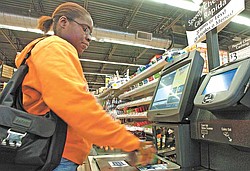Wal-Mart to try small on big scale
MCT
Tifany Greendge uses a self-serve checkout counter at a Wal-Mart Neighborhood grocery store in Orlando, Florida, in 2006. Wal-Mart is taking the neighborhood grocery store concept, now called Wal-Mart Market, around the country. (Dennis Wall/Orlando Sentinel/MCT)
Chicago Tribune
CHICAGO
Latasha Jones visits the Walmart Neighborhood Market in Indianapolis several times a week to stock up on fresh produce and baked goods.
The grocery store, on a busy thoroughfare just off Interstate 465, is a convenient stop on the way to work.
“This is the only place I shop for groceries,” said Jones, 27. “It’s cheaper than the Supercenter, and it’s always busy.”
If Wal-Mart Stores Inc. has its way, the same scenario will be repeated many times across urban neighborhoods as the world’s largest retailer unleashes a new strategy to gain access to the city.
The discount chain, best known for its football-field-sized Supercenters, plans to roll out dozens of small stores in the city in the next five years. The expansion is part of an effort to combat an unprecedented two-year decline in U.S. comparable-store sales by infiltrating the dense urban markets where Wal-Mart has little or no presence.
The small stores, operating under the banners Walmart Market and Walmart Express, are new to most of the country.
The Neighborhood Market concept, recently renamed Walmart Market, debuted in 1998 and accounts for 184 of the retailer’s approximately 4,400 U.S. stores. The first Express store has yet to open.
“As Wal-Mart’s growth [has] matured with Supercenters, they have to look for new avenues of growth, and that means getting into urban locations with a format that works,” said Michael Dart, a San Francisco-based retail strategist for Kurt Salmon consulting and co-author of “The New Rules of Retail.”
Wal-Mart first tinkered with the idea of small stores more than a decade ago as a way to learn the grocery business. The company initially rolled out a few dozen Neighborhood Markets (nicknamed “Small Marts” at the time) in Arkansas, Texas, Oklahoma and Florida.
But the concept didn’t get far. Instead of opening more free-standing grocery stores, Wal-Mart tacked the Market concept onto its discount stores, creating the 180,000-square-foot Supercenters Americans know so well. The grocery-selling Supercenters fueled the retailer’s growth for most of the past decade.
Today, Wal-Mart ranks as the nation’s largest grocer and generates more than half of its revenue from grocery sales. With suburbs and rural towns saturated with Supercenters, Wal-Mart is repurposing the slim Market format as a tool for getting into big cities.
The relatively diminutive size of Market and Express stores has advantages over the Supercenters. The new formats are small enough that Wal-Mart can move into vacant storefronts zoned for retail and avoid triggering city planning department reviews that come with larger projects.
In the end, the financial downturn paved the way for Wal-Mart to bring low-priced fresh food and jobs to depressed neighborhoods with its Supercenters. But even with the city’s blessing, opening Supercenters on the sites of former steel plants and manufacturing facilities is a slow process.
Wal-Mart can open small stores more quickly. Still, there are risks. Wal-Mart is unaccustomed to operating stores squeezed into a dense urban environment where its trucks need to navigate congested streets. It also has to figure out what urban shoppers will buy and choose the assortment of goods accordingly.
Wal-Mart is set to open its first Express next month in Gentry, Ark., near its corporate headquarters in Bentonville, just in time for the onslaught of investors and employees headed for its June 3 shareholders meeting. Wal-Mart is experimenting with what to carry in the 15,000-square-foot format, putting pharmacies in only some stores and varying the mix of fresh produce and general merchandise.
“The aim here, folks, is to get the right model so that we can rapidly roll these things out,” said Bill Simon, president and CEO of Wal-Mart U.S., at a Wall Street conference in March. “At our peak, we built about 350 Supercenters in a year, so when we get this right, these things are going to come real fast.”
The retailer is looking at hundreds of potential sites in Chicago alone, said Steven Restivo, director of community affairs at Wal-Mart.
The company opened its first city store in 2006 in Austin as a general merchandise discount store and later expanded it into a Supercenter.
“There are literally hundreds of opportunities,” Restivo said. “We want to provide more convenient access to our stores.”
Copyright 2011 Associated Press. All rights reserved. This material may not be published, broadcast, rewritten, or redistributed.
 43
43

